
(a)
Interpretation:
The fluid element deformation is to be sketched when
Concept Introduction:
Fluid element deformation occurs when the element changes its position with respect to its previous position. There are different types of deformation depending upon the aspect of change. These can be translation, rotation, angular, and volumetric deformations.
(a)
Answer to Problem 7.1P
The fluid element deformation when 1y
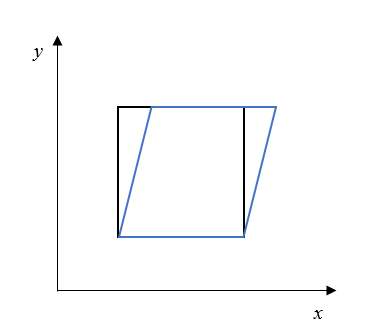
Explanation of Solution
Take a fluid element and plot it on a graph along x and y axis as shown below:
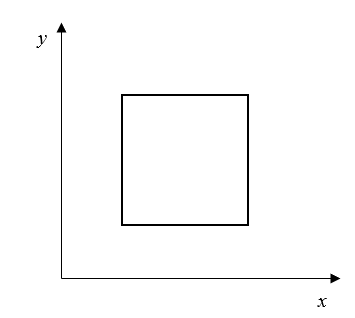
For a large change in
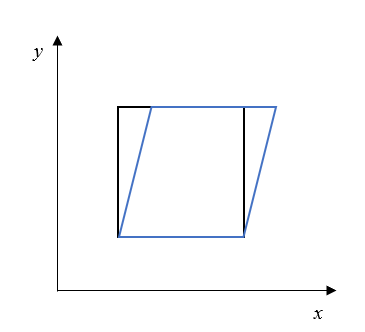
(b)
Interpretation:
The fluid element deformation is to be sketched when
Concept Introduction:
Fluid element deformation occurs when the element changes its position with respect to its previous position. There are different types of deformation depending upon the aspect of change. These can be translation, rotation, angular, and volumetric deformations.
(b)
Answer to Problem 7.1P
The fluid element deformation when
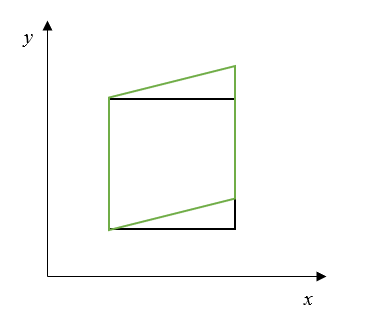
Explanation of Solution
Take a fluid element and plot it on a graph along x and y axis as shown below:

For a large change in
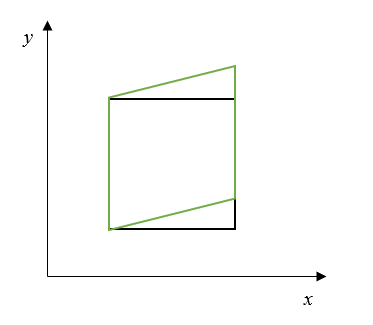
Want to see more full solutions like this?
Chapter 7 Solutions
Fundamentals of Momentum, Heat and Mass Transfer
- For forced convection, the important variables, their symbols, and dimensional representations are listed below. From the Buckingham method of grouping the variables, the rank of the dimensional matrix is 4. What is the number of independent dimensionless groups in this case? By utilizing the dimensional- analysis approach, find a dimensionless group. (Show just one dimensionless group you can find)arrow_forwardA parallel flow heat exchanger with surface area of 62.5 m2 is to be designed for cooling oil at 80oC with specific heat of 2.5 kJ/kg·oC and mass flow rate of 5.0 kg/s. Water at 15oC flowing at 9.94 kg/s is used as the cooling fluid (cp = 4.19 kJ/kg·oC). 1 W = 1 J/s Can you determine the heat transfer rate and outlet temperatures, assuming an overall heat transfer coefficient equal to 300 W/m2·oC. For heat transfer rate, use the effectiveness, ε, and Check the results with log-mean temperature difference approach. (Calculate the heat transfer rate and compare the value in (1))varrow_forwardA 5 cm diameter, 60 cm long aluminum cylinder initially at 50 oC is submerged in an ice-water bath at 2 oC. The convective heat transfer coefficient between the metal and the bath is 550 W/m2·K. Using the lumped parameter analysis, derive the equation below. Show procedures in detail please.And determine the central temperature of the aluminum after 1 min. For aluminum, k = 236 W/m·K, ρ =2702 kg/m3, and cp= 896 J/kg·K. (1 W = 1 J/s) Then calculate the cumulative heat transfer for the first 1 min.(the first law of theromodynamics is attached and the. needed equation to derive)arrow_forward
- Radioactive waste is stored in the spherical stainless-steel container as shown schematically in the figure below. Heat generated within the waste material must be dissipated by conduction through the steel shell and then by convection to the cooling water. Pertinent dimensions and system operating variables are Inside radius of steel shell, ri = 0.4 m; Outside radius of steel shell, ro = 0.5 m Volumetric rate of heat generated within waste material, q˙= 105 W/m3, Thermal conductivity of steel = 15 W/m·K; Thermal conductivity of waste = 20 W/m·K, Convective heat-transfer coefficient between steel shell and water, h = 800 W/m2·K, Water temperature, T∞ = 25 oC. In the stainless-steel shell, the temperature profile as a function of radius, r can be expressed as follows:Can you: At steady state, calculate the temperature at the outside steel surface (r = ro). And Calculate the temperature at the inside steel surface (r = ri).arrow_forwardcan you do specific control loop for dc including reboiler and condenserarrow_forwardThe periodic array below denotes a hypothetical lattice in 2D. 1. Is this a Bravais lattice? Why or why not? 2. Draw 3 different versions of unit cells. Of those 3, make one a primitive unit cell. 3. There is a special type of primitive unit cell that is called a ’Wigner-Seitz’ cell (look it up on- line, or in text books). In words, describe how it is defined, and draw it for the lattice above. 4. Why would it be useful to draw the primitive unit cell of a lattice as a Wigner-Seitz cell, rather than another random choice? Hint : What geometric property of a lattice was described to be useful in guessing material propertiesarrow_forward
- The schematic figure below shows a face-centered cubic (FCC) lattice with a lattice constant of a. Draw the lattice vectors of a primitive unit cell for the FCC lattice. Also write them in equation form and derive an expression for the reciprocal lattice vectors of an FCC lattice Using these sets of reciprocal lattice vectors, draw (or generate) the reciprocal lattice of FCC in re- ciprocal space. Show that this reciprocal lattice is equivalent to a body-centered cubic lattice with a lattice constant of 4pi/aarrow_forwardDerive the 3D density of states for a system of electrons with the dispersion relation (in the picture) Assume that there is no spin degeneracyarrow_forwardQ2) Design a Full Adder to add two numbers each of 3 digits.arrow_forward
- Q1) Design a Multiplexing system (shown below) to transmit six channels each of 10Kbps speed, through single channel with the following channel sequence: ch6, then ch1, then ch5, then ch2, then ch4, then ch3. The available clock is of 120KHz. (hint use jk flip flop in the timing and coding unit). Timing & code generator for the Clock 120KHz requested sequence CO C1 $2 --- $1 38 8 C2 Multiplexer C3 C4 C5arrow_forwardQ3) Compare two numbers (A,B) each of two digits either A>b or Aarrow_forwardHow will you select a suitable condensate techniquearrow_forwardarrow_back_iosSEE MORE QUESTIONSarrow_forward_ios
 Introduction to Chemical Engineering Thermodynami...Chemical EngineeringISBN:9781259696527Author:J.M. Smith Termodinamica en ingenieria quimica, Hendrick C Van Ness, Michael Abbott, Mark SwihartPublisher:McGraw-Hill Education
Introduction to Chemical Engineering Thermodynami...Chemical EngineeringISBN:9781259696527Author:J.M. Smith Termodinamica en ingenieria quimica, Hendrick C Van Ness, Michael Abbott, Mark SwihartPublisher:McGraw-Hill Education Elementary Principles of Chemical Processes, Bind...Chemical EngineeringISBN:9781118431221Author:Richard M. Felder, Ronald W. Rousseau, Lisa G. BullardPublisher:WILEY
Elementary Principles of Chemical Processes, Bind...Chemical EngineeringISBN:9781118431221Author:Richard M. Felder, Ronald W. Rousseau, Lisa G. BullardPublisher:WILEY Elements of Chemical Reaction Engineering (5th Ed...Chemical EngineeringISBN:9780133887518Author:H. Scott FoglerPublisher:Prentice Hall
Elements of Chemical Reaction Engineering (5th Ed...Chemical EngineeringISBN:9780133887518Author:H. Scott FoglerPublisher:Prentice Hall
 Industrial Plastics: Theory and ApplicationsChemical EngineeringISBN:9781285061238Author:Lokensgard, ErikPublisher:Delmar Cengage Learning
Industrial Plastics: Theory and ApplicationsChemical EngineeringISBN:9781285061238Author:Lokensgard, ErikPublisher:Delmar Cengage Learning Unit Operations of Chemical EngineeringChemical EngineeringISBN:9780072848236Author:Warren McCabe, Julian C. Smith, Peter HarriottPublisher:McGraw-Hill Companies, The
Unit Operations of Chemical EngineeringChemical EngineeringISBN:9780072848236Author:Warren McCabe, Julian C. Smith, Peter HarriottPublisher:McGraw-Hill Companies, The





